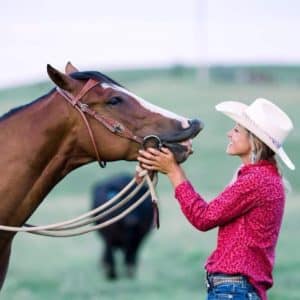Becoming Your Own Horseman

[Photo: submitted by Elsabe Hausauer]
There’s a saying, “The best teachers are those who show you where to look but don’t tell you what to see.”
Same goes for learning “FEEL & TIMING” when training horses. A trainer can tell you what to do with your hands, seat, legs and/or what bit to try to get a certain result. However, working on your feel and timing is something you often learn on your own by sitting on many different kinds of horses and really working on YOURSELF.
Many people ride their entire life and still don’t get the feel and timing thing. I know in my own journey that my horsemanship improved tremendously once I started working more on myself and really study the science on how the horse’s brain and body biomechanics work. I am a work-in-progress, because the more I know the more I realize just how much there is I don’t know. I absolutely love the journey though, and I embrace the growing pains because I know sometimes those are crucial for my horse and I to grow. Even if growing means 10% every day.
Understanding the brain…
We often forget that humans are a “thinking and reasoning” species, and horses are a “sensory and moving” species. Horses, unlike humans, don’t have a big, developed frontal lobe. I know people often talk about horses having two brains, hence why we worked both sides of the horse, but in reality the horse has one brain with two hemispheres, which are well-connected by a structure called the corpus callosum.
So why are horses very one-sided? Well, because they have a very underdeveloped corpus callosum, which is the connective tissue between the two hemispheres of the brain that allows messages to go from one side of the brain to the other thats why its crucial to work both sides of the horse’s brain.
“Horses are horses and behave as horses should. They have no alternative. It’s humans who decide to label certain of these behaviors as stubborn, lazy, or sour. In training situations, chronic states of stress and conflict increasingly emerge when an association between what we are asking of the horse and what is expected is not clear enough for the horse to understand. It is within this framework that most so-called problem horses develop,” says Dr. Steven Peters who is a board-certified neuropsychologist specializing in brain functioning.
Remember horses live in the present moment. They don’t think about the future. They don’t think about the upcoming junior/high school rodeo, the next show or competition. They live here, right now at this present moment with us. Horses teach us so much about mindfulness. Horse also remember past experiences which is why its so important to be mindful when our horses are struggling with things mentally. Good leadership and consistency creates confidence.
Learning Feel and timing in the body…
Often times, I feel the best way to learn feel is to sit on a horse that’s really broke. A horse who rides off your seat and legs and drives from behind with lots of freedom in the front end effortlessly. A horse who is soft in the face, jaw, neck, and travels square. One who doesn’t, brace, pull, hide behind the bit, or travel like a wet noodle. Let a trainer guide you on a horse like that, so you know what to LOOK for and what to FEEL. The horse will always be your best teacher.
Last but not least, be your own horseman. Ride with many people, but find your own style and really study the horse himself. Don’t get so caught up riding with so many different people that you try to compare your journey to theirs or try to ride like them. Remember God put this incredible animal on your path for a reason. Embrace the journey learning more about yourself and your horse at a deeper level.
Each and everyone of us have gifts and talents. 1 Peter 4:10 says, “Each one should use whatever gift he has received to serve others, faithfully administering God’s grace in its various forms”
Your gifts are for you to share with others — in other words, embrace those gifts and talents. Be authentic and be the best horseman you can be by BEING YOU. It’s okay to have set backs, it’s okay for things to fall apart. Sometimes we need those set backs to get to ahead.

[Photo: submitted by Elsabe Hausauer]
And REMEMBER:
“Successful people are life-long learners who push themselves out of their comfort zones. While most people think that when they graduate college, they are finished being a student, successful people remain students. They are constantly learning new things and have new experiences. They aren’t afraid to try new things and to fail at them then try again.”

Elsabe Hausauer is a veteran in the horse training industry. She is the owner of MBR Performance Horses, LLC, clinician, and as she puts it, “forever student of the horse.” Horsewoman, rancher, wife, and mother by way of South Africa, she hangs her hat in Halliday, ND, encouraging the relationship between people and horses through teaching and advocating horsemanship skills to make each ride a better experience.
